Alvin Cheung
FrontierCS: Evolving Challenges for Evolving Intelligence
Dec 17, 2025Abstract:We introduce FrontierCS, a benchmark of 156 open-ended problems across diverse areas of computer science, designed and reviewed by experts, including CS PhDs and top-tier competitive programming participants and problem setters. Unlike existing benchmarks that focus on tasks with known optimal solutions, FrontierCS targets problems where the optimal solution is unknown, but the quality of a solution can be objectively evaluated. Models solve these tasks by implementing executable programs rather than outputting a direct answer. FrontierCS includes algorithmic problems, which are often NP-hard variants of competitive programming problems with objective partial scoring, and research problems with the same property. For each problem we provide an expert reference solution and an automatic evaluator. Combining open-ended design, measurable progress, and expert curation, FrontierCS provides a benchmark at the frontier of computer-science difficulty. Empirically, we find that frontier reasoning models still lag far behind human experts on both the algorithmic and research tracks, that increasing reasoning budgets alone does not close this gap, and that models often over-optimize for generating merely workable code instead of discovering high-quality algorithms and system designs.
Autocomp: LLM-Driven Code Optimization for Tensor Accelerators
May 24, 2025Abstract:Hardware accelerators, especially those designed for tensor processing, have become ubiquitous in today's computing landscape. However, even with significant efforts in building compilers, programming these tensor accelerators remains challenging, leaving much of their potential underutilized. Recently, large language models (LLMs), trained on large amounts of code, have shown significant promise in code generation and optimization tasks, but generating low-resource languages like specialized tensor accelerator code still poses a significant challenge. We tackle this challenge with Autocomp, an approach that empowers accelerator programmers to leverage domain knowledge and hardware feedback to optimize code via an automated LLM-driven search. We accomplish this by: 1) formulating each optimization pass as a structured two-phase prompt, divided into planning and code generation phases, 2) inserting domain knowledge during planning via a concise and adaptable optimization menu, and 3) integrating correctness and performance metrics from hardware as feedback at each search iteration. Across three categories of representative workloads and two different accelerators, we demonstrate that Autocomp-optimized code runs 5.6x (GEMM) and 2.7x (convolution) faster than the vendor-provided library, and outperforms expert-level hand-tuned code by 1.4x (GEMM), 1.1x (convolution), and 1.3x (fine-grained linear algebra). Additionally, we demonstrate that optimization schedules generated from Autocomp can be reused across similar tensor operations, improving speedups by up to 24% under a fixed sample budget.
TWIX: Automatically Reconstructing Structured Data from Templatized Documents
Jan 11, 2025



Abstract:Many documents, that we call templatized documents, are programmatically generated by populating fields in a visual template. Effective data extraction from these documents is crucial to supporting downstream analytical tasks. Current data extraction tools often struggle with complex document layouts, incur high latency and/or cost on large datasets, and often require significant human effort, when extracting tables or values given user-specified fields from documents. The key insight of our tool, TWIX, is to predict the underlying template used to create such documents, modeling the visual and structural commonalities across documents. Data extraction based on this predicted template provides a more principled, accurate, and efficient solution at a low cost. Comprehensive evaluations on 34 diverse real-world datasets show that uncovering the template is crucial for data extraction from templatized documents. TWIX achieves over 90% precision and recall on average, outperforming tools from industry: Textract and Azure Document Intelligence, and vision-based LLMs like GPT-4-Vision, by over 25% in precision and recall. TWIX scales easily to large datasets and is 734X faster and 5836X cheaper than vision-based LLMs for extracting data from a large document collection with 817 pages.
LLM-Aided Compilation for Tensor Accelerators
Aug 06, 2024Abstract:Hardware accelerators, in particular accelerators for tensor processing, have many potential application domains. However, they currently lack the software infrastructure to support the majority of domains outside of deep learning. Furthermore, a compiler that can easily be updated to reflect changes at both application and hardware levels would enable more agile development and design space exploration of accelerators, allowing hardware designers to realize closer-to-optimal performance. In this work, we discuss how large language models (LLMs) could be leveraged to build such a compiler. Specifically, we demonstrate the ability of GPT-4 to achieve high pass rates in translating code to the Gemmini accelerator, and prototype a technique for decomposing translation into smaller, more LLM-friendly steps. Additionally, we propose a 2-phase workflow for utilizing LLMs to generate hardware-optimized code.
Optimizing Speculative Decoding for Serving Large Language Models Using Goodput
Jun 20, 2024



Abstract:Reducing the inference latency of large language models (LLMs) is crucial, and speculative decoding (SD) stands out as one of the most effective techniques. Rather than letting the LLM generate all tokens directly, speculative decoding employs effective proxies to predict potential outputs, which are then verified by the LLM without compromising the generation quality. Yet, deploying SD in real online LLM serving systems (with continuous batching) does not always yield improvement -- under higher request rates or low speculation accuracy, it paradoxically increases latency. Furthermore, there is no best speculation length work for all workloads under different system loads. Based on the observations, we develop a dynamic framework SmartSpec. SmartSpec dynamically determines the best speculation length for each request (from 0, i.e., no speculation, to many tokens) -- hence the associated speculative execution costs -- based on a new metric called goodput, which characterizes the current observed load of the entire system and the speculation accuracy. We show that SmartSpec consistently reduces average request latency by up to 3.2x compared to non-speculative decoding baselines across different sizes of target models, draft models, request rates, and datasets. Moreover, SmartSpec can be applied to different styles of speculative decoding, including traditional, model-based approaches as well as model-free methods like prompt lookup and tree-style decoding.
Mélange: Cost Efficient Large Language Model Serving by Exploiting GPU Heterogeneity
Apr 22, 2024



Abstract:Large language models (LLMs) are increasingly integrated into many online services. However, a major challenge in deploying LLMs is their high cost, due primarily to the use of expensive GPU instances. To address this problem, we find that the significant heterogeneity of GPU types presents an opportunity to increase GPU cost efficiency and reduce deployment costs. The broad and growing market of GPUs creates a diverse option space with varying costs and hardware specifications. Within this space, we show that there is not a linear relationship between GPU cost and performance, and identify three key LLM service characteristics that significantly affect which GPU type is the most cost effective: model request size, request rate, and latency service-level objective (SLO). We then present M\'elange, a framework for navigating the diversity of GPUs and LLM service specifications to derive the most cost-efficient set of GPUs for a given LLM service. We frame the task of GPU selection as a cost-aware bin-packing problem, where GPUs are bins with a capacity and cost, and items are request slices defined by a request size and rate. Upon solution, M\'elange derives the minimal-cost GPU allocation that adheres to a configurable latency SLO. Our evaluations across both real-world and synthetic datasets demonstrate that M\'elange can reduce deployment costs by up to 77% as compared to utilizing only a single GPU type, highlighting the importance of making heterogeneity-aware GPU provisioning decisions for LLM serving. Our source code is publicly available at https://github.com/tyler-griggs/melange-release.
Evaluation of LLMs on Syntax-Aware Code Fill-in-the-Middle Tasks
Mar 07, 2024



Abstract:We introduce Syntax-Aware Fill-In-the-Middle (SAFIM), a new benchmark for evaluating Large Language Models (LLMs) on the code Fill-in-the-Middle (FIM) task. This benchmark focuses on syntax-aware completions of program structures such as code blocks and conditional expressions, and includes 17,720 examples from multiple programming languages, sourced from recent code submissions after April 2022 to minimize data contamination. SAFIM provides a robust framework with various prompt designs and novel syntax-aware post-processing techniques, facilitating accurate and fair comparisons across LLMs. Our comprehensive evaluation of 15 LLMs shows that FIM pretraining not only enhances FIM proficiency but also improves Left-to-Right (L2R) inference using LLMs. Our findings challenge conventional beliefs and suggest that pretraining methods and data quality have more impact than model size. SAFIM thus serves as a foundational platform for future research in effective pretraining strategies for code LLMs. The evaluation toolkit and dataset are available at https://github.com/gonglinyuan/safim, and the leaderboard is available at https://safimbenchmark.com.
AST-T5: Structure-Aware Pretraining for Code Generation and Understanding
Jan 05, 2024



Abstract:Large language models (LLMs) have made significant advancements in code-related tasks, yet many LLMs treat code as simple sequences, neglecting its structured nature. We introduce AST-T5, a novel pretraining paradigm that leverages the Abstract Syntax Tree (AST) for enhanced code generation, transpilation, and understanding. Using dynamic programming, our AST-Aware Segmentation retains code structure, while our AST-Aware Span Corruption objective equips the model to reconstruct various code structures. Unlike other models, AST-T5 avoids intricate program analyses or architectural changes, so it integrates seamlessly with any encoder-decoder Transformer. Evaluations show that AST-T5 consistently outperforms similar-sized LMs across various code-related tasks. Structure-awareness makes AST-T5 particularly powerful in code-to-code tasks, surpassing CodeT5 by 2 points in exact match score for the Bugs2Fix task and by 3 points in exact match score for Java-C# Transpilation in CodeXGLUE. Our code and model are publicly available at https://github.com/gonglinyuan/ast_t5.
Online Speculative Decoding
Oct 17, 2023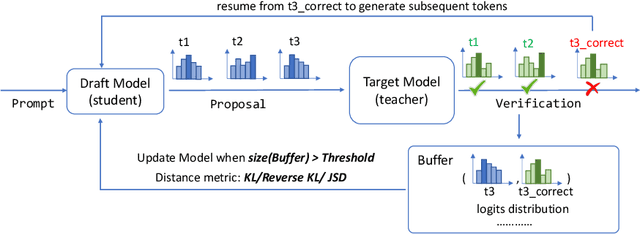
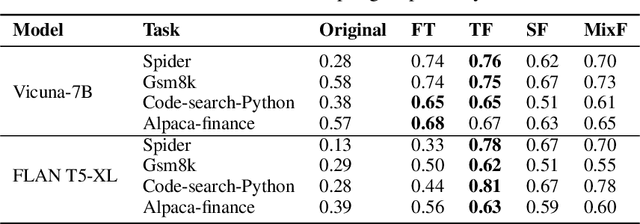
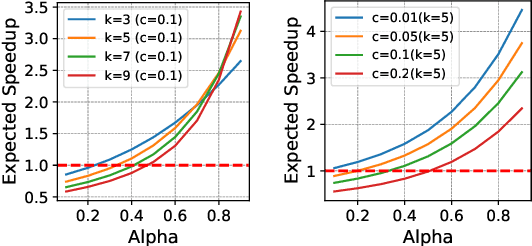
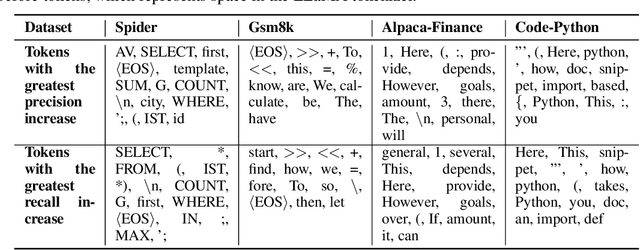
Abstract:Speculative decoding is a pivotal technique to accelerate the inference of large language models (LLMs) by employing a smaller draft model to predict the target model's outputs. However, its efficacy can be limited due to the low predictive accuracy of the draft model, particularly when faced with diverse text inputs and a significant capability gap between the draft and target models. We introduce online speculative decoding (OSD) to address this challenge. The main idea is to continually update (multiple) draft model(s) on observed user query data using the abundant excess computational power in an LLM serving cluster. Given that LLM inference is memory-bounded, the surplus computational power in a typical LLM serving cluster can be repurposed for online retraining of draft models, thereby making the training cost-neutral. Since the query distribution of an LLM service is relatively simple, retraining on query distribution enables the draft model to more accurately predict the target model's outputs, particularly on data originating from query distributions. As the draft model evolves online, it aligns with the query distribution in real time, mitigating distribution shifts. We develop a prototype of online speculative decoding based on online knowledge distillation and evaluate it using both synthetic and real query data on several popular LLMs. The results show a substantial increase in the token acceptance rate by 0.1 to 0.65, which translates into 1.22x to 3.06x latency reduction.
Spatialyze: A Geospatial Video Analytics System with Spatial-Aware Optimizations
Aug 08, 2023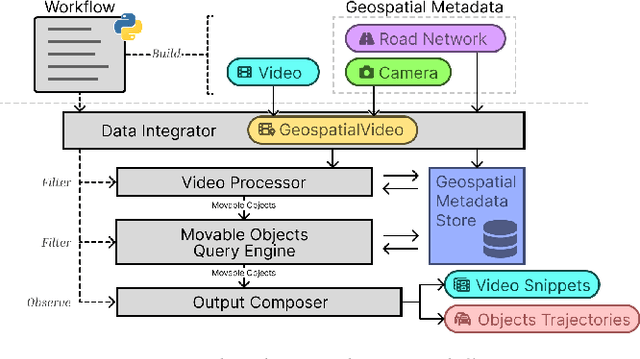
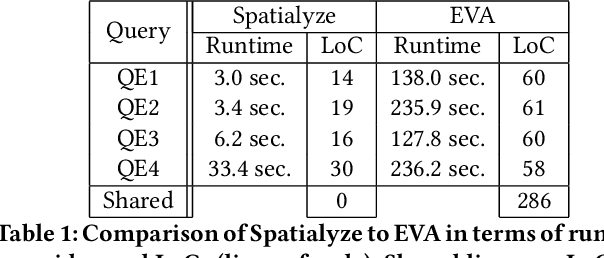
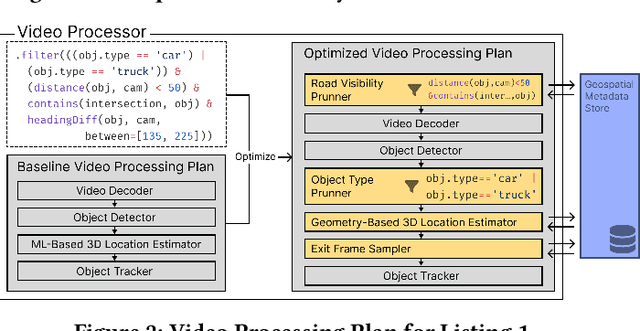
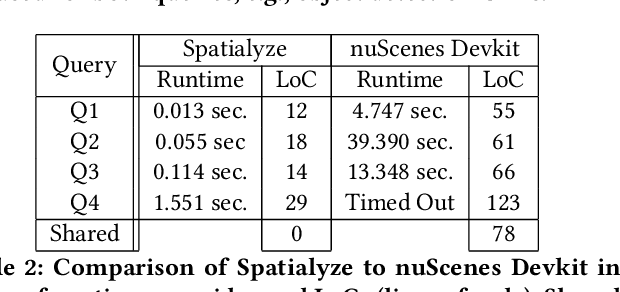
Abstract:Videos that are shot using commodity hardware such as phones and surveillance cameras record various metadata such as time and location. We encounter such geospatial videos on a daily basis and such videos have been growing in volume significantly. Yet, we do not have data management systems that allow users to interact with such data effectively. In this paper, we describe Spatialyze, a new framework for end-to-end querying of geospatial videos. Spatialyze comes with a domain-specific language where users can construct geospatial video analytic workflows using a 3-step, declarative, build-filter-observe paradigm. Internally, Spatialyze leverages the declarative nature of such workflows, the temporal-spatial metadata stored with videos, and physical behavior of real-world objects to optimize the execution of workflows. Our results using real-world videos and workflows show that Spatialyze can reduce execution time by up to 5.3x, while maintaining up to 97.1% accuracy compared to unoptimized execution.
 Add to Chrome
Add to Chrome Add to Firefox
Add to Firefox Add to Edge
Add to Edge